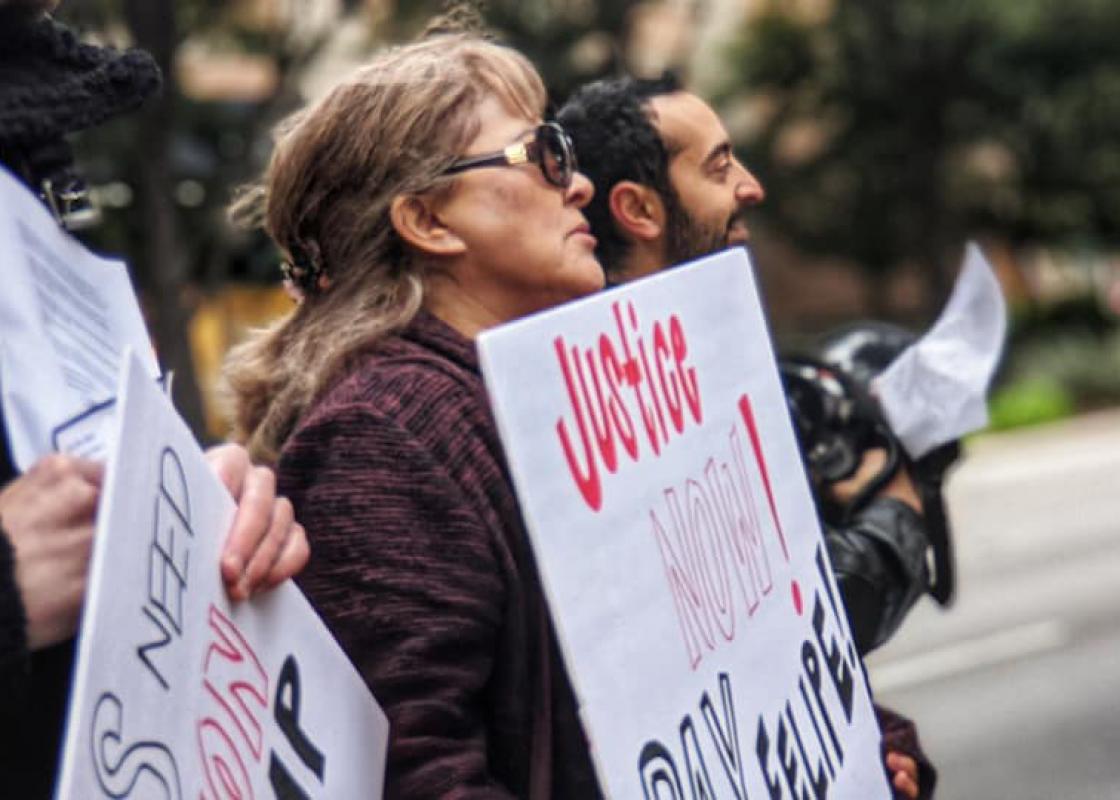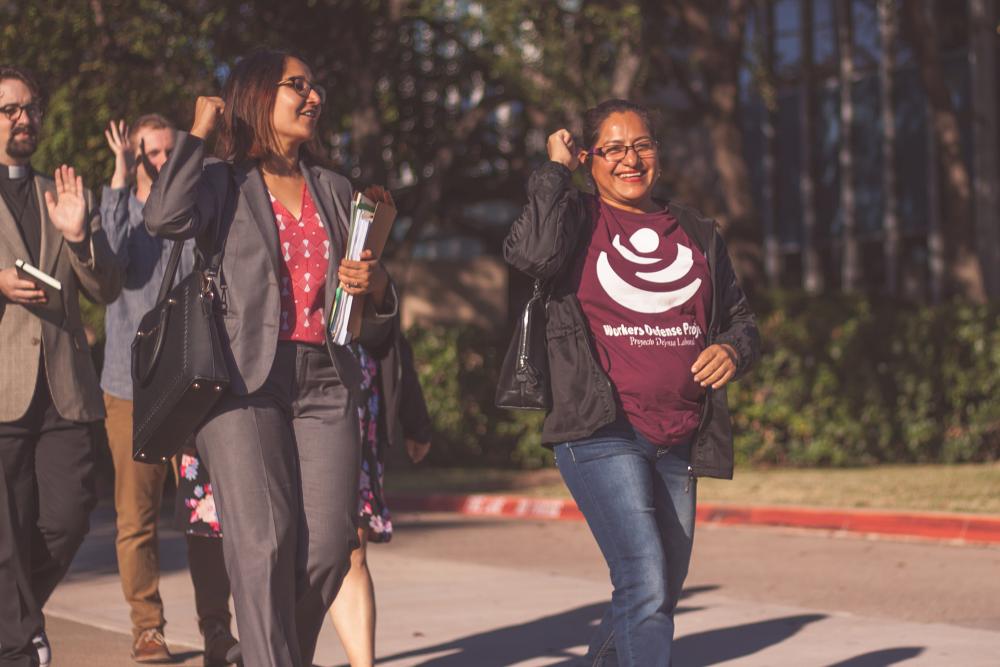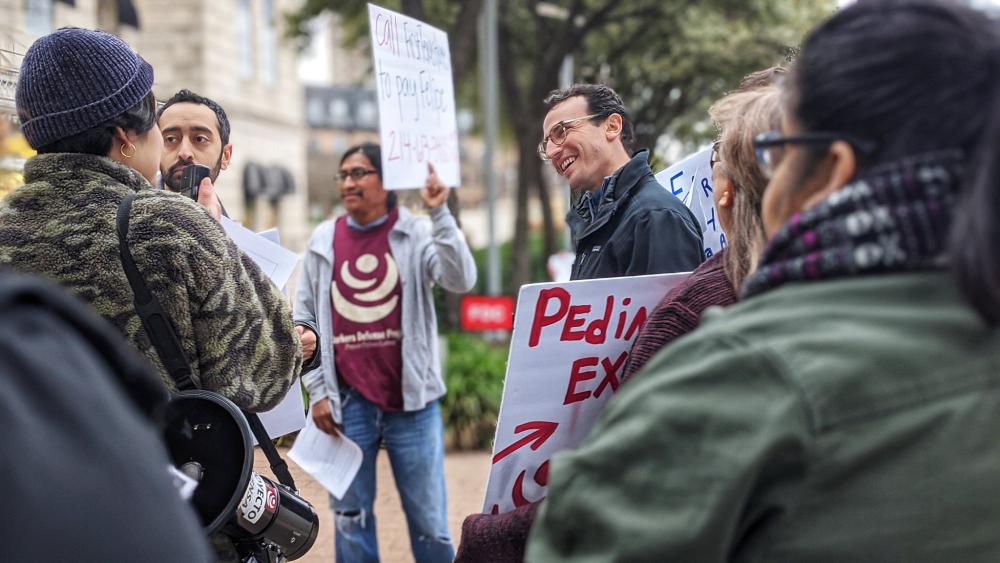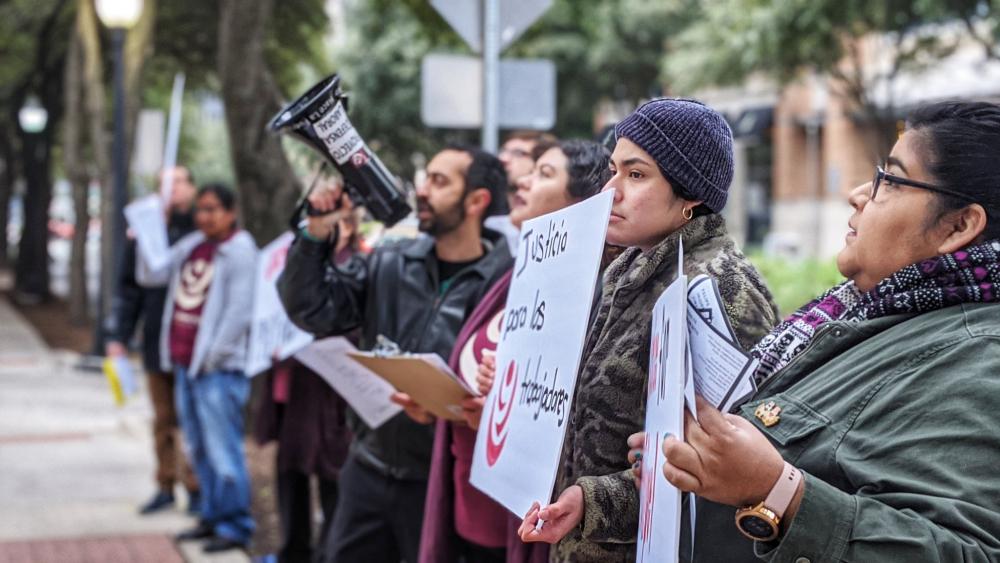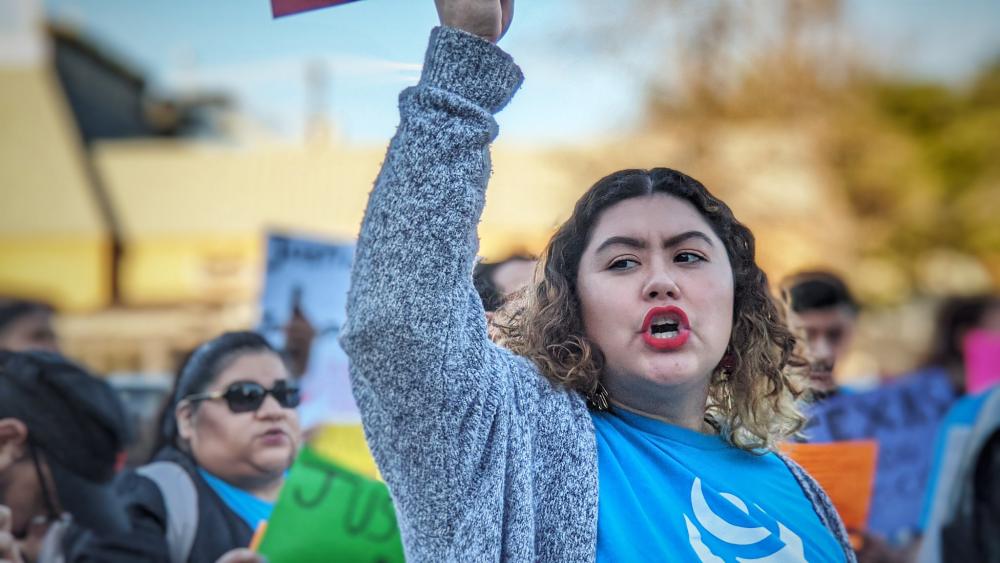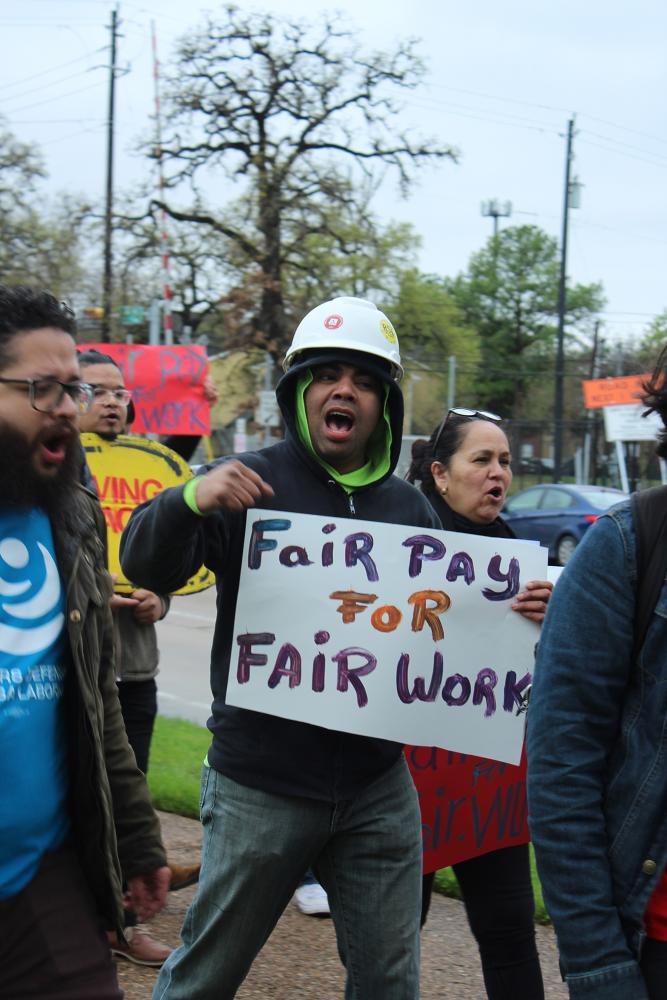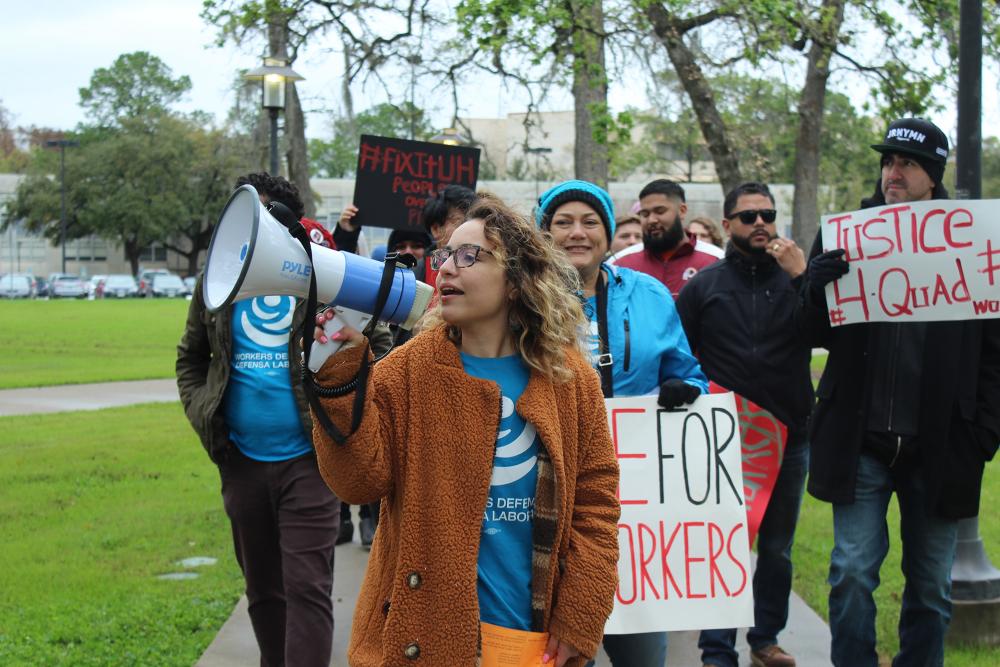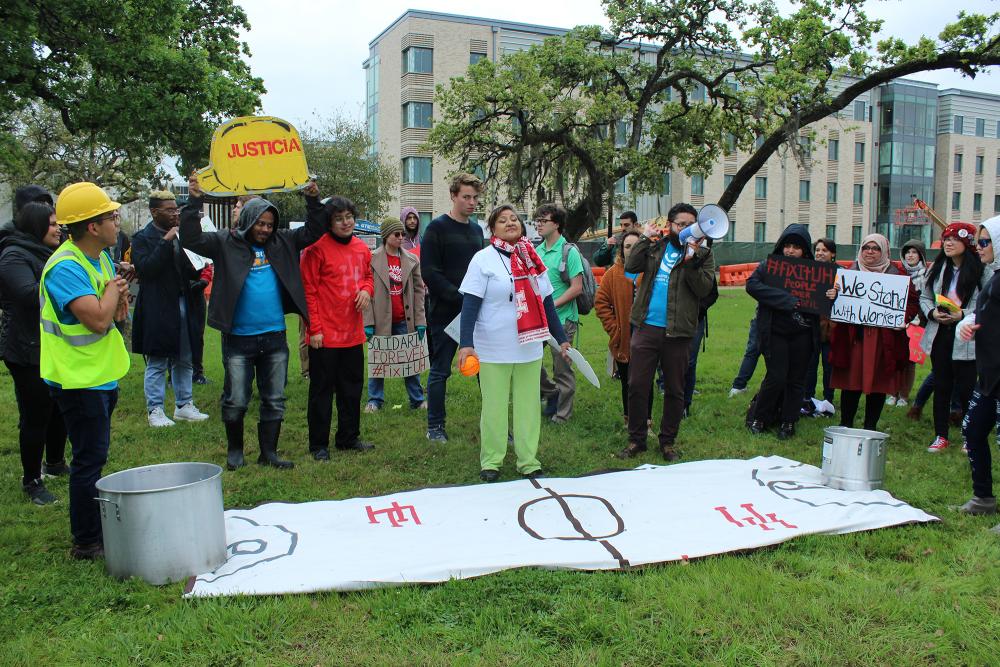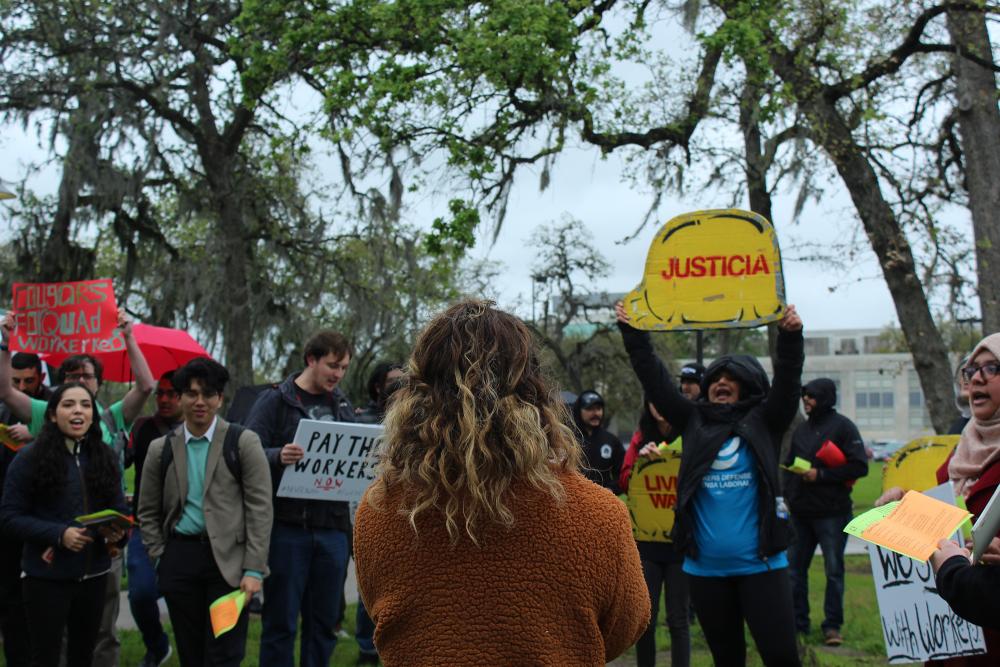Workers Defense Project, or Proyecto Defensa Laboral, is an organization that champions better working conditions for construction workers in Texas. RDA’s virtual gala Who Builds Our City? focused on the workers who have built, are building, and will build Houston. To continue thinking about this important topic, Cite editor Jack Murphy recently spoke with Emily Timm, Co-Executive Director of Workers Defense Project about their efforts, including the important bills that are under consideration during this session of the Texas legislature.
Jack Murphy: Thanks for speaking with me, Emily! To start, could you tell me about Workers Defense Project? How did the organization begin?
Emily Timm: Workers Defense Project (WDP) is a statewide, membership-based organization that builds power for low-wage working immigrants across Texas. We focus on improving conditions in the construction industry. We started about fifteen years ago, largely around the issue of wage theft, which is a common occurrence in the construction sector where employers would either underpay or refuse to pay workers for their labor. Our organization came together around the worker’s right to be paid.
From there, we began to understand other issues with construction worksites. There were higher rates of injuries and even fatalities than we had expected. Through research with the University of Texas and other partnerships, we identified problems through statistics that we were hearing from our members.
Our organization advocates for workers access to safety training, paid sick leave, rest breaks, and higher wages to ensure that construction jobs are good, safe jobs with a viable career path.
Where is WDP active in Texas?
Our members are low-wage workers in Houston, Austin, and Dallas. They come to the organization for legal support or because they want to initiate improvements in their workplace. They become members and participate in organizing campaigns to improve working conditions and advocate for policies that protect workers.
Many low-wage workers in Texas are immigrants. How is immigration policy relevant to this effort?
Immigration is a factor, but I want to start with the construction industry itself.
The construction industry is structured so companies competitively bid to obtain contracts. The lowest bidder is often preferred; there’s a drive to be competitive. Unfortunately, this condition forces costs down. Due to the nature of subcontracting in the construction industry, this places the responsibility to actually employ workers on the smallest companies on the jobsite who have the least ability to provide protections, benefits, training, and a career path.
In addition, there’s the issue of misclassification. One study found that 38% of workers in the Houston construction industry are misclassified as independent contractors. That is all wrapped up in immigration and the fact that such a large portion of the construction workforce in Texas—over 70% of construction workers are foreign-born and 50% are undocumented.
And in some circumstances, like with public work, going with the lowest bid is required.
Yes. Companies regularly formulate low bids by lowering the amount they pay their subs, taking away the investment in job skills and safety training, or cutting worker’s wages. This cost cutting all gets passed down.
I read in one of WDP’s studies that Texas is one of the deadliest states for construction workers. Why is that the case?
There are widespread problems. A worker dies in Texas from a workplace injury every three days. This statistic makes Texas one of the deadliest states in the country for workers. Basic safety protections like rest breaks, protective equipment, and clean drinking water are often absent on the worksite.
Texas is also the only state that doesn’t require workers’ compensation coverage. That any employer can opt out of providing coverage to their employees is a huge burden. We see that basic safety training recommended, not required, by OSHA is generally absent. So, most workers don’t have access to basic safety training, and this puts them at even greater risk.
On top of these deadly conditions, construction has been hit hard by COVID-19. We don't have great data from Harris County, but we know that in Travis County, construction workers are five times as likely to be hospitalized with COVID-19 as workers in other sectors. We suspect the rates are true for other parts of Texas.
There have been efforts by local governments to put pandemic safety guidelines in place on construction sites, but there’s been pushback from state leadership and from Governor Abbott around implementing and enforcing those safety standards. On top of longstanding issues and poor working conditions that construction workers have faced for years, the pandemic places workers in this whole other risk category.
The influence of unions has decreased in the past decades. How do unions factor into this struggle?
Union density is less than 5% in Texas, which is very low compared to other states. Unions played an important role historically and today are relevant to creating good jobs in the construction industry. They provide high-quality training and apprenticeship programs that establish a career pathway, from an entry-level apprentice all the way up to a journeyman worker who is highly skilled and highly compensated, including benefits. Union construction jobs do exist here in Texas, but they are an increasingly small portion of the construction sector. This has had a widespread impact in declining standards for construction workers at large.
We advocate for and work with workers who are generally not working in a union work environment, with little time to improve conditions and no agreements for protection in place. We're trying to raise standards through policy, which has a widespread impact on raising the bar throughout the industry. Unions are supportive of that. They have an interest in raising standards to make responsible contractors, whether union or nonunion, more competitive in the construction industry.
In Who Builds Our City?, RDA’s recent virtual gala, we focused on the conditions for skilled workers in Houston. Is there a difference in the concerns of skilled versus unskilled workers generally?
I contend that all construction workers are highly skilled workers. I don't know how to fix drywall in my house or frame a shed or pour a foundation. Workers should be compensated for their skill and there should be training opportunities to prepare for a highly skilled profession.
There is a correlation with pay; workers who are considered “less skilled” are correspondingly paid less. Workers earning poverty wages or barely above poverty wages are more likely to not have workers' compensation coverage and are more likely to experience wage theft. There’s definitely a connection between low-paid work and other labor violations.
Construction sites are very specialized work environments. If you’re moving things around or even doing cleaning, you’re in a specialized work environment that requires specialized training.
Can you tell me about WDP’s Better Builder® Program?
Since 2008, we’ve focused on the construction industry because so many of our members reported wide-spread abuses in that sector. We worked with our members to identify the biggest challenges facing them on the worksite.
This led to the creation of the Better Builder® Program. With this effort we advocate for publicly funded construction projects to follow these standards, and we want this to be the standard for the industry. It covers living wages, health and safety regulations, and benefits including workers compensation coverage, skills training, and compliance with local labor laws. One of the standards is a 10-hour safety training course for workers and a 30-hour course for supervisors. This program incentivizes training so more workers move into training programs and better jobs.
The Better Builder® program also includes an independent monitor to ensure compliance. It’s a pledge that developers and end users sign to uphold these standards on the site.
This led to other member-led policy campaigns; one success is a basic right to a rest break that passed in Austin and Dallas. This provides workers with a guaranteed minimum rest break. Our research found that a third of the workforce wasn’t regularly getting a rest break in the morning and in the afternoon.
What has the response been to this program?
We've got a lot of traction around the Better Builder® Program in central Texas, which has raised standards on over $2 billion dollars’ worth of construction. It has improved working conditions for around 34,000 construction workers and provided workers with access to workers compensation coverage and safety training, sometimes for the first time in their careers. We’ve also passed a number of policies that run parallel to the Better Builder® Program in Harris County which center on affordable housing development.
How does Houston's construction market compare to the rest of Texas?
Houston is the biggest construction market in the state. About one out of every four construction projects in Texas are in Houston. It’s huge—around 250,000 workers labor in Houston.
We found that the Houston area has a significant number of employers of undocumented immigrants and that less than 40% of the workforce had access to workers compensation, which is a bit lower than what we have seen in other places. We also saw that heat related illnesses and injuries were particularly prevalent in Houston because of its subtropical climate. In 2015, there were five Houston workers who died from heat exposure, which may not sound like a lot, but only thirty-seven workers died of heat exposure in the whole country that year. 35% of workers said they didn't have rest breaks, and 17% said they had to stop work at some point because they felt sick in the heat.
We’ve been working in Houston since 2017, the year of Hurricane Harvey. There were additional safety challenges and widespread wage theft in much of the reconstruction after Hurricane Harvey. Our major focus was to make sure that public dollars coming in to support recovery in Houston were being used to create good jobs in the construction industry and protecting against labor abuse on those sites. During some of the first rounds of funding, we worked on a hundred thousand dollars of wage claims for workers doing recovery work.
What incentives are there for owners to change their practices? How is the Better Builder® program different than what Construction Career Collaborative (C3) offers?
It's important to say that some actors in the industry are beginning to take steps to address some of these issues. It's also a sign that these issues are not just bad for workers, but they're also bad for business. They're bad for responsible contractors who provide training, protective equipment, and a living wage. It’s much harder for them to be competitive. It’s also an indicator that there's a benefit to both the construction sector as a whole and to individual contractors when addressing these dire conditions.
One of the major differences is that our Better Builder® Program establishes a set of standards. We focus on slightly different constituents; C3 often works with contractors, and largely specialty contractors. Our program only works with owners and developers, so it’s a slightly different approach.
Is there a relationship between higher standards and construction costs?
The question of cost is an interesting one, because you have to address the cost of unsafe and deadly conditions, which aren’t often spoken about. Construction costs don’t account for the effects of wage theft for workers and the cost of injuries and accidents that can have huge fiscal costs which get passed on to taxpayers and hospitals if individuals are uninsured. There’s also the costs worksite stoppages; work might stop for several days if someone was injured. Or lost time of a general contractor or owner dealing with wage theft or a legal issue. The Better Builder® program has a small cost to implement the program, but it is offset by the other potential costs that could be disastrous.
Do you have a sense on the relationship between construction quality and appropriate compensation? I would think that fairly compensated workers produce better buildings.
We don't have data on that, but if the workforce is well compensated, well rested, not stressed, and not overburdened, you're more likely to have high quality work performed. One thing the Better Builder® Program does is create an incentive for workers who are being given the opportunity to go through training programs to develop their construction skills.
If architects and designers are interested in making and supporting change on these issues, what should they know? What should they be thinking about?
As professionals in this sector, you have an important perspective to contribute when policy is being considered by the City of Houston or Harris County. Be supportive; call your elected official and let them know that you as a professional in the construction field at large are supportive of these measures. Encourage engineers and developers to learn more about the Better Builder® program and to get involved to make a difference on the projects that they are working on.
What’s at stake for our cities if meaningful work on these issues isn’t realized? Why is this so important for Texas’s future?
For construction to be a viable career path, there needs to be real change in the industry to make construction jobs desirable jobs. Historically, construction work was a job that moved people out of poverty and into the middle class. So, there’s immense potential for the construction industry to be a desirable career path. It’s highly skilled and can be very well compensated. Construction is a $96 billion industry in Texas. But that means changes have to be made to make it attractive for workers in the current workforce to stay and to attract new young talent.
Creating pathways through higher education programs is an important piece as well. To have quality programs attached to apprenticeship programs, things like that. There’s a connection around higher education, too. We have been working on cases regarding the University of Houston. There have been widespread cases of workers not being paid the prevailing wage. WDP organized a group of workers and has had tremendous support from students and faculty in support of these workers to help recover wages for work done building dormitories and other buildings for the university. Universities have a critical role to play, whether they're public or private, to ensure that their investments in construction are resulting in the creation of good, safe construction jobs that are desirable and allow people to make a living and have a career path.
The Texas legislature is in session right now. What are current bills that we should know about that could impact construction safety?
There are some important bills that could impact the ability of local and city government and entities to address unsafe conditions in the construction sector.
SB 14 would broadly prohibit counties and cities from passing policies that could protect workers. It would strip away local protections that our members have fought to have for years, including basic protections, like accessing safety training, providing rest breaks, ensuring that workers on public projects have access to workers compensation. Our concern is that if SB 14 passes, only state elected leaders and federal elected officials will be able to address these issues. It’s important to maintain protections that have been won over the years and make sure that local governments' hands aren’t tied to address local needs.
This bill not only attempts to tie the hands of construction workers and undo worker protections but would also tie the hands of local governments from enforcing other civil rights protections.
Are there any other bills we should watch?
There are a couple of other bills which we are actively pushing and hope will gain some traction. HB 405 would extend the statute of limitations for filing wage theft claims. Now people only have six months to file a claim. HB 776 which would guarantee construction workers the right to workers' compensation, and HB 3656, which seeks to address misclassification in the construction industry.
How did Winter Storm Uri affect your members and the construction industry more broadly?
Like so many Texans, our members were hard hit by the storm. Many of them were without power for days, some for even weeks. Folks living in low-income apartment complexes, were without water and electricity for a week after the storm. Like many things, the storm more heavily burdened low wage workers and their families who were already living from paycheck to paycheck. They have less of a safety net or reserves to fall back on. It also meant losing work—nobody was building—nobody was working throughout the whole storm and for many days after while things thawed out. There are a lot of families reeling from that storm. Our organization pivoted in the moment to provide direct assistance for our members, directing people to resources and access to food and water. It’s not normally what we do, but in the moment, it was needed. People had loss of income, damage to homes, and other challenges. The storm was called a natural disaster, but it was really a crisis that was a manmade crisis and a manmade crisis by state leadership. It brought us close to the brink of a total power shutdown in the city. We wanted to make sure that the impact of that on working families and regular families was lifted up, as it wasn't lifted up at the state capital. We’ve been doing some reflection and sharing out, mostly on social media. We subsequently filed HB 3460, a bill called the Providing Ongoing Water and Energy Resources (POWER) to Texas Consumers Act, which would provide additional assistance for recovery for impacted families.
What else is there to say about the effects of the winter storm?
One more thing about the blackout. Folks made vulnerable due to COVID-19 also struggled with this manmade crisis. During the pandemic, there was a dynamic in which Harris County would put policies in place, only to have them rolled back by the governor. Meaning: construction workers were declared essential workers by the governor in the pandemic in order to force construction sites back open when, at the same time, public health officials recommended closing them to minimize transmission of COVID-19.
It’s clear that construction workers deserve our support. They were always essential workers and should be considered as such. If we want to deem them essential workers and have them keep working through the crisis, then we need to provide essential protections for them. We have this awareness now; we should utilize it.
For nearly 20 years, Emily Timm has fought tirelessly for workplace justice and immigrants’ rights in Texas and across the country. She is Co-Executive Director at Workers Defense Project, an organization she co-founded in 2005, and has since been instrumental in building the organization into a statewide powerhouse that empowers low-wage construction workers to achieve fair, safe employment. Today, Workers Defense Project is one of the leading advocacy organizations in Texas, with a membership of thousands and offices in Houston, Dallas, and Austin.


